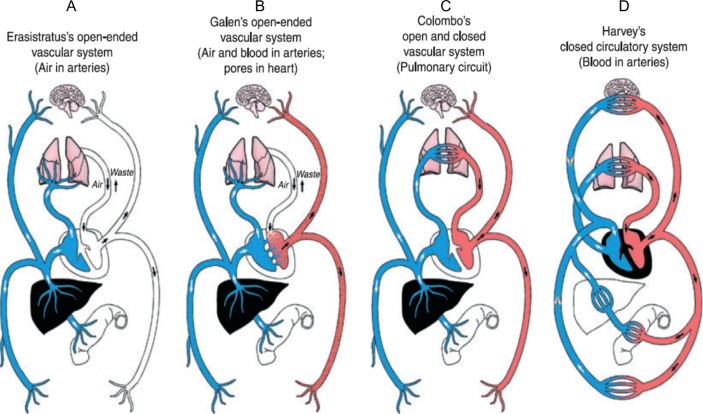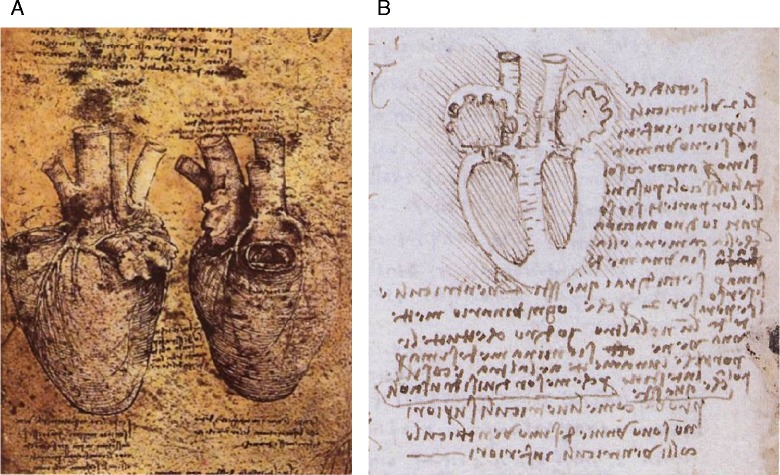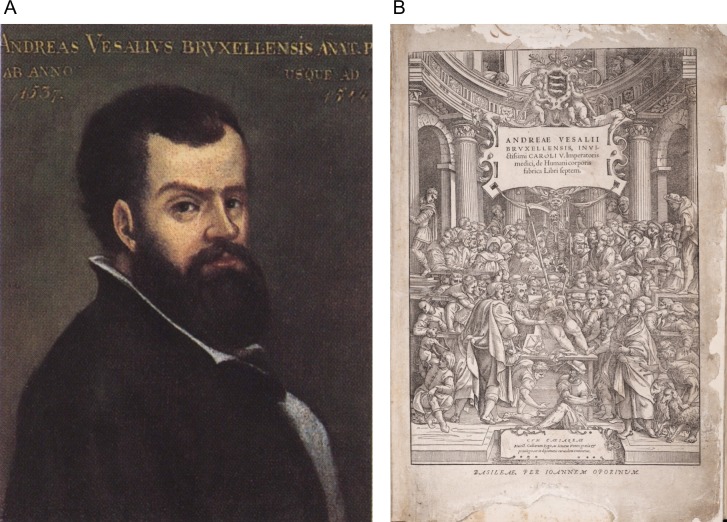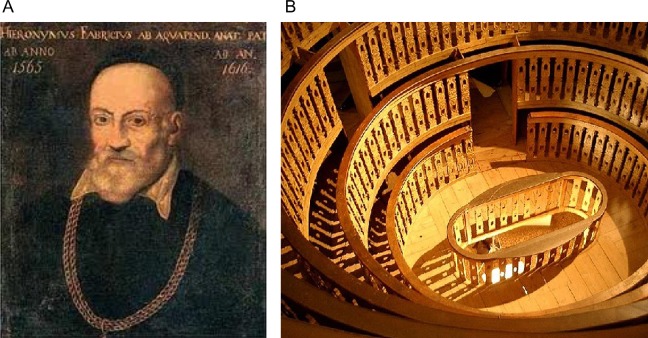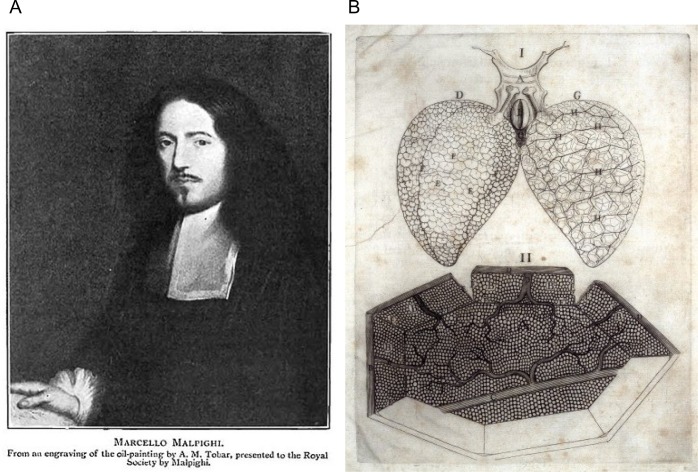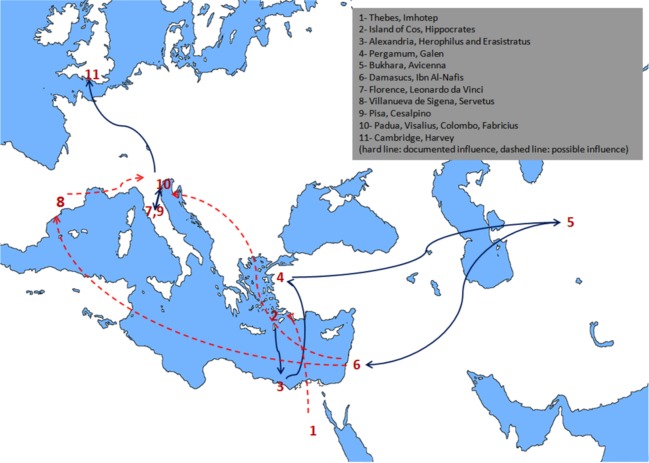Abstract
In his quest to comprehend his existence, Man has long been exploring his outer world (macro-cosmos), as well as his inner world (micro-cosmos). In modern times, monmental advances in the fields of physics, chemistry, and other natural sciences have reflected on how we understand the anatomy and physiology of the human body and circulation. Yet, humanity took a long and winding road to reach what we acknowledge today as solid facts of cardiovascular physiology. In this article, we will review some of the milestones along this road.
“The history of the pulmonary circulation provides a measure of Man's thinking about himself and his place in the Universe.” 1 Alfred P. Fishman (1918–1990), president of American Physiological Society.
The heart in ancient Egyptian medicine
The ancient Egyptians considered the heart as the central organ of the body, both physiologically and spiritually. The earliest hieroglyphic depiction of the heart was as an organ with eight vessels attached to it (Figure 1A). After the third Dynasty, the heart was modified to a simpler jar-shape (Figure 1B) 2 .
Figure 1.
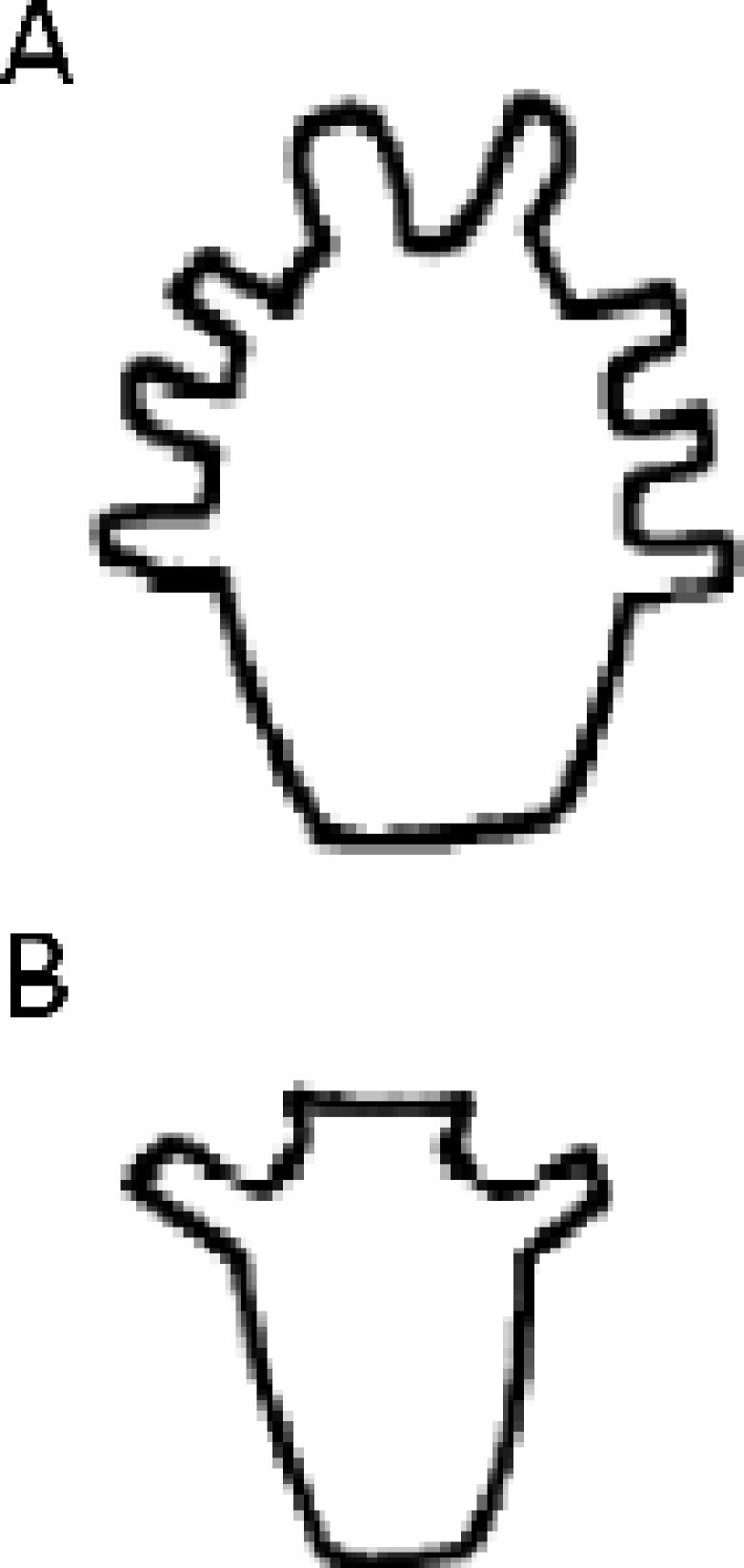
Hieroglyphic depictions of the heart: (A) The early depiction of the heart with 8 vessels connected to it. (B) The simpler jar-shaped depiction of the heart used after the third Dynasty.
The Smith papyrus (ca. 1600 BC) is the oldest known surgical treatise on trauma. It was named after Edwin Smith, the American Egyptologist who purchased the scroll in Luxor in 1862. Many historians believe that the text of the Smith papyrus was copied from a much older document originally written by Imhotep, the prominent high priest and physician of the Old Kingdom (ca.3000-2500 BC). The first phrases of the Smith papyrus (ca. 1600 BC) demonstrated that ancient Egyptians directly associated the pulse with the heart: “The counting of anything with the fingers (is done) to recognize the way the heart goes. There are vessels in it leading to every part of the body. When a Sekhmet priest, any sinw doctor… puts his fingers to the head to the two hands, to the place of the heart… it speaks in every vessel, every part of the body” 2,3 .
In the Ebers medical Papyrus (ca. 1555 BC), the heart is again described as the centre of a system of vessels supplying the body. Going beyond underlining the importance of pulse examination, the text also alludes to cardiac rhythm disturbances and heart failure: “From the heart arise the vessels which go to the whole body… if the physician lay his finger on the head, on the neck, on the hand, on the epigastrium, on the arm or the leg, everywhere the motion of the heart touches him, coursing through the vessels to all the members…. When the heart is diseased, its work is imperfectly performed; the vessels proceeding from the heart become inactive so that you cannot feel them… If the heart trembles, has little power and sinks, the disease is advancing.” 2
The Egyptian cardiovascular medicine cannot be entirely separated from spirituality and mysticism, as the heart played a pivotal role in the ancient Egyptian theology. However, the early Egyptian medicine, with its advanced clinical examination and diagnosis, paved the way to the scientific foundations of Greek and Roman medicine.
Hippocrates and the four humours
Hippocrates of Cos (460-377 BC) is recognized by most scientific historians as the Father of Medicine. He revolutionized the views of medicine and disease, mainly by recognizing that disease occurred naturally and was not due to divine punishment. The Hippocratic Corpus is a collection of around seventy medical works from Alexandrian Greece. The Corpus was most probably not written by a single person, as it had different writing styles and variable subjects. It can be attributed, by consequence, to the “Hippocratic School”, a group of disciplines sharing similar views and methods 2 .
In the Corpus, Hippocrates and his contemporaries theorized that health is a state of balanced humours while disease was a state of imbalanced humours. These humours are blood, black bile, yellow bile, and phlegm. The four humours correspond to the four elements of nature (earth, wind, fire, and water) that reflect the four primary physical qualities (hot, cold, dry, and wet). Each humour was characterized by one of the four elements and a couple of the four qualities: blood, for instance, corresponded to the “fire” and was “hot” and “wet”. The behaviour and effects on the body of each humour was strictly related, by analogy, with these physical characteristics. Thus, the blood, being hot and wet, was related to the “natural heat” of the body and its eventual prevalence could cause fever. The concept of the four humours would influence the medical paradigms, including those regarding the cardiovascular system for long centuries to come (Figure 2) 4,5 .
Figure 2.
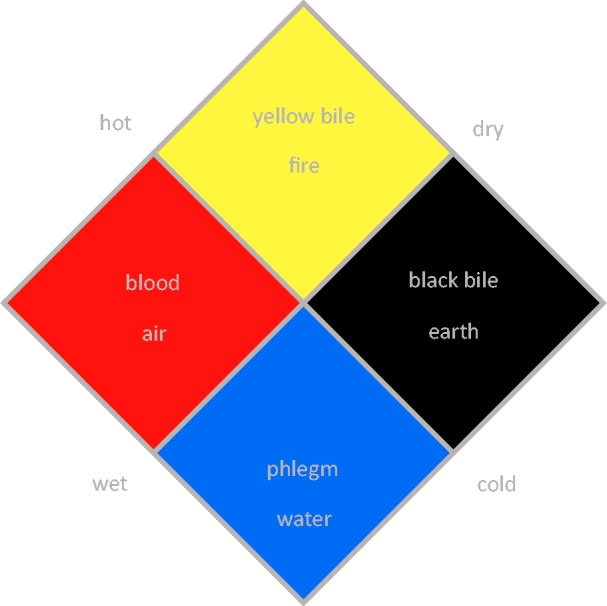
The four humours of Hippocratic medicine are the black bile (melan chole), bile (chole), phlegm (phlegm), and blood (haima).
The School of Alexandria
Around 300 years before Christ, Alexandria boasted a remarkable cultural and intellectual advancement. The Alexandria School of Medicine was mainly founded on the teachings of Hippocrates. In this era, three eminent figures shaped the views of their contemporaries on the cardiovascular system: Praxagoras, Herophilus, and Erasistartus.
Praxagoras of Cos (340 BC) was a renowned anatomist in the early history of the Alexandrian medicine. He was the first to identify anatomical differences between arteries and veins. He theorized that arteries begin in the heart and carry pneuma, while veins originate in the liver and carry blood. On semeiotics, he was of the very first to recognize the diagnostic values of the pulse.
Herophilus of Chalcedon (355-260 BC), was a scholar of Praxagoras. He produced a large volume of anatomical writings on central nervous, gastrointestinal, and reproductive systems. Regarding cardiovascular system, Herophilus recognized that arteries are thicker than veins; he also noticed the exception of this rule at the lung vessels.
Erasistratus of Iulis on Ceos (315-240 BC), working initially with Herophilus, considered the heart to be the source of both arteries and veins. He postulated an open-air system in which veins distribute blood through the body, while arteries contain air alone. However, he did observe that arteries – when punctured – do bleed. To explain the paradox of bleeding arteries, he suggested that blood moves from veins to arteries via invisible channels after the arteries empty their content of air to the body 3 (Figure 3).
Figure 3.
Cardiovascular models over the course of time. (A) Erasistratus' model (B) Galen's model (C) Colombo's model (D) Harvey's model. Reference: Arid WC. Discovery of the cardiovascular system: from Galen to William Harvey. Journal of Thrombosis and Haemostasis, 9 (suppl. 1).
Galen of Pergamenon
Claudius Galenus, the prominent physician, surgeon and philosopher, was born in Pergamum (currently located near the city of Bergama in Turkey) around 129 AD (Figure 4). He studied medicine in Pergamum, Smyrna, Corinth, and Alexandria. He later resided in Rome and became the physician of the Roman emperors: Marcus Aurelius, Commodus, and Septus Severus. By the time of his death (between 207 and 216 AD), Galen had left an almost unsurpassed legacy of medical and philosophical writings. Galen's theories would impact medical sciences for long centuries, influencing Roman, Islamic and Renaissance scholars.
Figure 4.
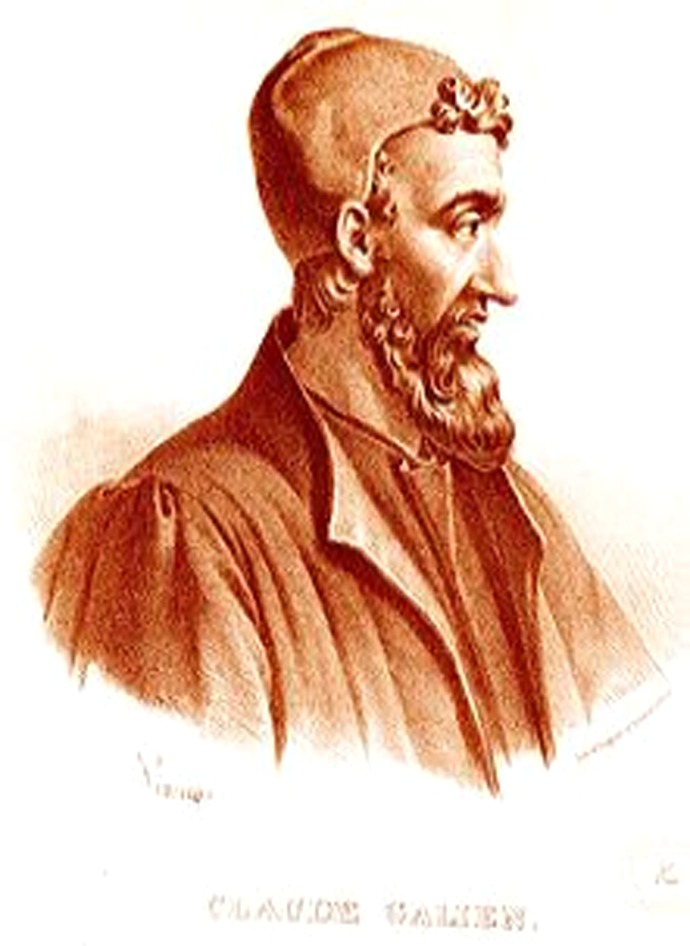
Claudius Galenus, better known as Galen of Pergamon (129–207?).
Galen's medical theories were founded on the Greek anatomy and physiology background and on Aristotle's deductive logic. Galen adopted the four humours paradigm, emphasizing the importance of the role of nutrition in human physiology. However, most of Galen's anatomical studies were based on observations made on living or dead animals, particularly apes and oxen, as he was not allowed access to human bodies.
According to Galen, the liver was the source of all veins and the principle organ for blood production. Nutrients were concocted in the gut to form chyle which was then transformed into blood by the liver. The blood moved from the hepatic vein to the vena cava and supplied all parts of the body above and below the liver. In contrast to Erasistratus theory, Galen believed that arteries were filled with blood, which was infused with the vital spirits by a mixture of air from the lungs through the pulmonary vein and heat from the heart. The blood passed from the right ventricle to the left ventricle through invisible pores present in the inter-ventricular septum. The heart itself was not a muscle and did not have a pumping function; blood simply passed through it. Like Erasistratus, Galen adopted that blood was not recycled, but rather evaporated or consumed by the organs through a single-pass open system 6 (Figure 3).
Galen's theory remained dominant until the fall of the Roman Empire. Also during the medieval ages in the Latin West, there was no interest to challenge ancient Greek and Roman science. In fact, Galen's work was fitted to Christian doctrine and thus rendered immune to questioning. This dogmatic view on Galen's teachings would last till the rise of the Renaissance in Europe.
The Renaissance
Leonardo da Vinci
The Renaissance polymath Leonardo da Vinci (1452-1512) was one of the first Westerns to oppose the anatomical dogmas of Galen. In contrast to Galen, da Vinci described the heart as a muscle and considered the atria as cardiac chambers. His anatomical drawings of the heart and its valves were highly accurate (Figure 5A). Of interest, da Vinci also provided first descriptions of atherosclerotic coronaries. However, da Vinci was influenced by the Galenic anatomy. For instance, he drew the four chambers of the heart clearly depicting the invisible pores for the passage of blood from the right to the left ventricle (Figure 5B) 6 .
Figure 5.
(A) A sketch of ox's heart by Leonardo da Vinci. Many of da Vinci's heart drawings were made from studies of the organs of pigs and oxen. Only later in his life that he had access to human organs. The script was written in the famous mirror-image da Vinci's style. The sketch is one of Windsor Folios, part of the Royal Collection, Windsor, UK. (B) From the same collection, a sketch of human's heart by Leonardo, where the interventricular pores are clearly depicted according to Galen's anatomy.
Servetus
Michael Serveto (1511-1553), was a Spanish philosopher and theologian (Figure 6A). He published a theological treatise entitled “Christianismo restituti” where he challenged the views of Galen and proposed that blood must pass from the right ventricle to the lungs, where it is mixed with air and then back to the left ventricle (Figure 6B). The exact details of how a theologian, who never systematically conducted a systematic anatomical research, reached these conclusions are still unknown. Servetus' views on religion and non-trinitarian Christology were condemned by both Catholics and Protestants. Michael Servetus was eventually denounced by John Calvin and was burnt, with most of his books, at the stake as a heretic by the city council of Geneva 7 .
Figure 6.
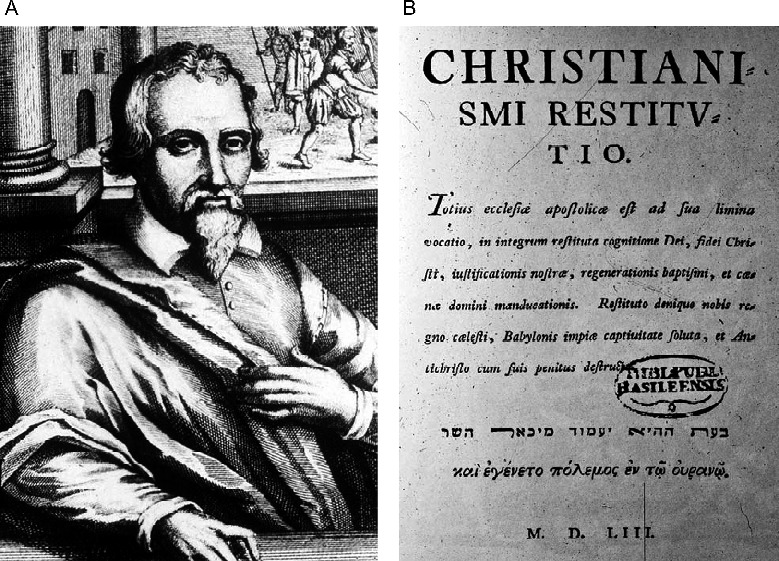
Michael Servetus (A), also known as Miguel Serveto (1509–1553), was a Spanish Theologian and Humanist. In his theological treatise, “Christianismo restituti” (The Restoration of Christianity) (B), he first described the function of pulmonary circulation in the Western world. The “Christianismo Restituti” was condemned by Catholics and Protestants alike.
The School of Padua
The University of Padua is one of the oldest universities in the world. It was founded in 1222 by a group of scholars from University of Bologna seeking more academic freedom. During the Renaissance and under the influence of the Republic of Venice, Padua University medical school witnessed its golden age. Because of its academic autonomy and independence of political or religious influences, Padua was the destination of Europe's best scientists of the time 8 .
Andreas Vesalius (1514–64) was born in Brabant (modern-day Belgium). He was a professor of anatomy at the University of Padua and considered by many as the founder of modern anatomy (Figure 7A). By the age of 29, Vesalius had reshaped the study of human anatomy through his seven-book masterpiece “De humani corporis fabrica”, published in 1543 (Figure 7B). Unlike Galen, Vesalius carried out human corpse dissections systematically and challenged many of Galen's anatomical views. In the sixth book of the fabrica, focusing on the heart and associated organs, Vesalius rectified Galen's notion that the great blood vessels originate from the liver. Moreover, in the second 1555 edition, he questioned the existence of the inter-ventricular pores 9 .
Figure 7.
Andreas Vesalius (A) (1514–1564), as a Professor of Anatomy at the University of Padua, he laid the foundations of modern anatomy with his masterpiece “De Humani Corporis Fabrica” (B).
Realdo Colombo (1516–1559), was an Italian anatomist and a scholar of Vesalius at the University of Padua (Figure 8). Colombo could not prove the presence of the inter-ventricular pores described by Galen. He theorized the pulmonary transit of blood instead of its passing through the invisible pores 10 . Interestingly, Colombo was a contemporary of Servetus. However, he made no reference to Servetus. The question whether Servetus was influenced by Colombo, or the other way around, or they produced their work independent of each other, was never resolved.
Figure 8.
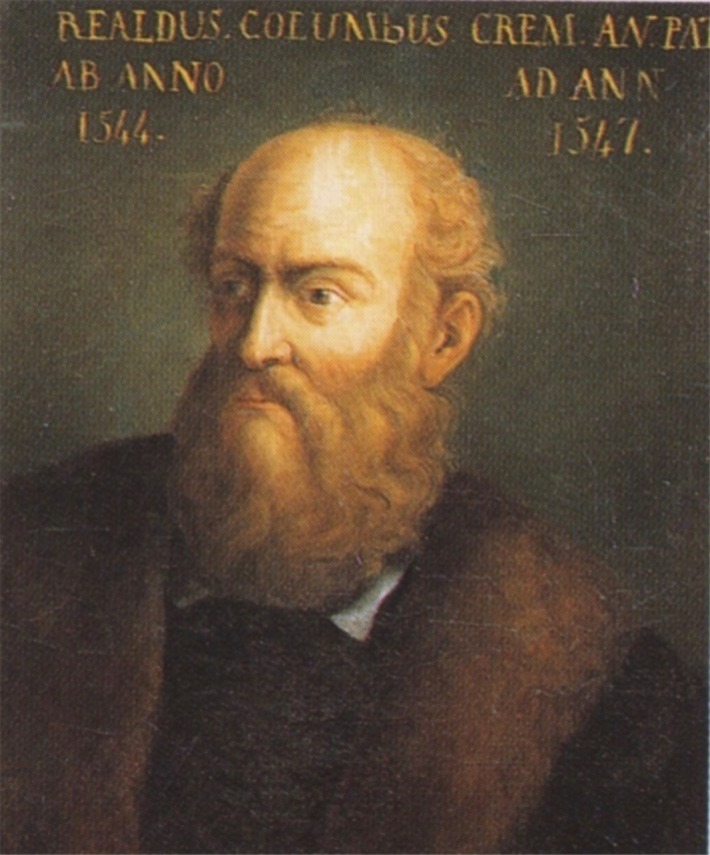
Realdo Colombo, anatomy professor at the University of Padua, decribed the pulmonary circulation around the same time as Servetus.
Girolamo Fabrizio d'Aquapendente
Fabrizio d'Aquapendente (1537-1619), also known as Fabricius, was a pioneer in embryology, anatomy, and surgery (Figure 9A). During his professorship in Anatomy in Padua, the first stable anatomical theatre in the world was built. This anatomical theatre is still present at Palazzo Del Bo at the University of Padua (Figure 9B). His anatomical studies included a description of the valves present in large veins which render the backward flow of venous blood improbable 11 . Fabricius was the anatomy and surgery professor by the time William Harvey was studying medicine in Padua.
Figure 9.
During his professorship in Anatomy in Padua of Fabrizio d'Aquapendente (A) (1537–1619), the first stable anatomical theatre in the world was built. This anatomical theatre is still present at Palazzo Del Bo at the University of Padua (B).
Andrea Cesalpino's Circulation
Andrea Cesalpino (1519-1603), was the director of the botanical garden in Pisa (Figure 10). He had limited studies in physiology. He theorized the pulmonary circulation without knowing the work of Realdo Colombo. Cesalpino formally coined the term “Circulation” to describe the physiology of blood. However, his concepts on circulation were chemical rather than physical, involving the continuous evaporation and condensation of blood. He was also one of the first to draw attention towards the swelling of the vein which takes below and never above the ligation, in contrast to Galen's teachings 6 .
Figure 10.
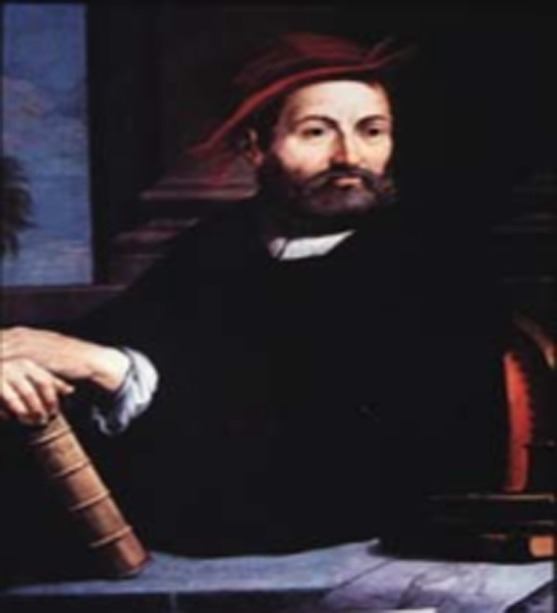
Andrea Cesalpino (1519–1603).
William Harvey
William Harvey (1578-1657) was born in Kent, England (Figure 11A). In 1597, he finished his degree in arts at Gonville and Caius College, Cambridge. He later studied medicine in Padua, the greatest medical school of the time. In Padua, he was directly influenced by Fabricius and Galileo. In 1628, Harvey published his groundbreaking theory on blood circulation in a modest 72-page book written in Latin, entitled “Exercitatio anatomica de motu cordis et sanguinis in animalibus”. Harvey's work was met with much scepticism at the time of its publication as it challenged the existing dogmas of the time 6 .
Figure 11.
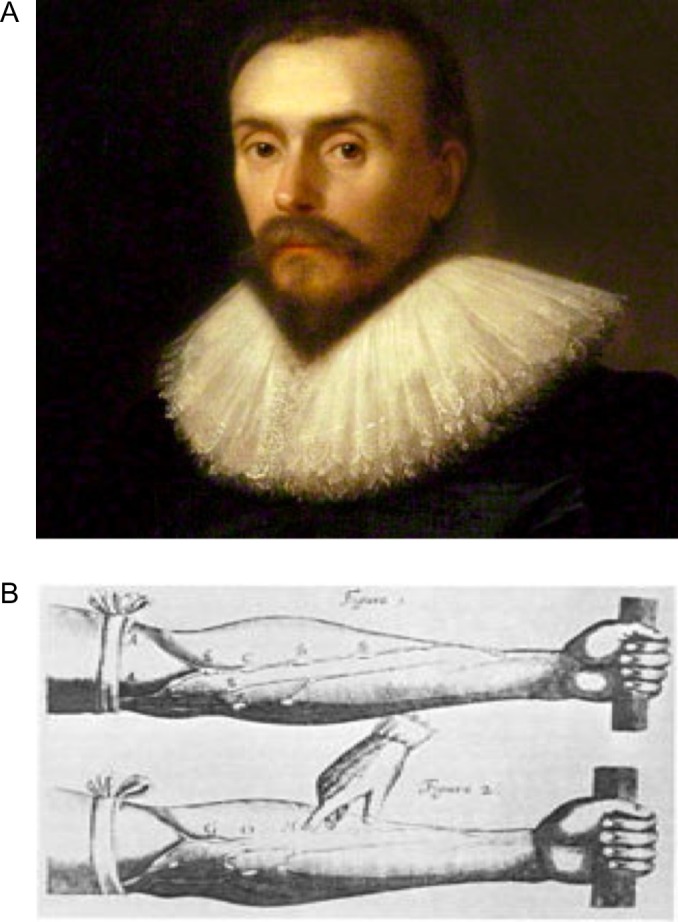
William Harvey (1578–1657) (A). Engravings published by Harvey in De motu cordis proving by two types of tourniquets that the blood enters the limb by arteries and returns from it by veins. The first tourniquet is a tight tourniquet with reduced arterial blood flow to the limb, resulting in loss of pulse on the wrist and a cold hand. The arteries proximal to the ligature beome distended. The second tourniquet is medium – tight tourniquet with unimpaired arterial flow to the limb, but with reduced venous return, resulting in distended veins on the limbs and the hand become swollen and blue (B).
In his seminal “de motu cordis et sanguinis”, Harvey laid the foundation of the modern concepts of blood circulation. He postulated that the main organ responsible for circulation was the heart and not the liver. He disagreed with the notion that the right ventricle only serves to nourish the lungs, and that blood passes from the right ventricle to the left ventricle through invisible inter-ventricular pores. He approved Colombo's views that blood must pass from the right side through a pulmonary transit to the left side of the heart. He also theorized that the intrinsic motion of the heart originate is the systole and not the diastole, and that arterial pulsations were due to impulses of the blood from the left ventricle. By estimating the cardiac output in about 12 kilos (3.000 “drachmas”) of blood every 30 minutes, Harvey argued that the quantity of blood is too great to be explained by a single-pass, open system and that blood must move in a circulatory pattern. Using his classical tourniquet experiment, Harvey demonstrated that blood moved into the limbs through the arteries and returned from it through the veins (Figure 11B). He also endorsed Fabricius'teachings that backward flow in the veins was not possible because of the venous valves. Harvey opposed the Galenic tradition that blood evaporated through skin breathing. Instead, he proposed that blood passed from the arterial side to the venous side through pores in the tissue 6,12 .
Marcello Malpighi
In the de motu cordis, Harvey alluded to the possible presence of pulmonary capillaries and called them “pulmonum caecas porositates et vasorum eorum oscilla”, that is “the invisible porosity of the lungs and the minute cavities of their vessels”. Marcello Malpighi (1628–1694) was an Italian physician, working in Pisa and Bologna, and one of the early pioneers of microscopical anatomy and histology (Figure 12A). With the help of the newly invented microscope, Malpighi solidified Harvey's concepts and was the first man ever to describe the pulmonary capillaries and alveoli 13 (Figure 12B).
Figure 12.
With the help of the newly invented microscope, Marcello Malpighi (A) (1628–1694) solidified Harvey's concepts and was the first man ever to describe the pulmonary capillaries and alveoli (B).
The role of Ibn Al-Nafis
Three centuries before the works of Servetus, Colombo, Harvey, and Malpighi, the eminent thirteenth century Syrian physician Ibn Al-Nafis described the pulmonary circulation, alluding also to the presence of the pulmonary capillaries 14 . In a document entitled “Commentary on Anatomy in Avicenna's Canon”, the 29-year-old Ibn Al-Nafis challenged the classical anatomical teachings of Avicenna (Figure 12).
Avicenna (Ibn Sina in Arabic) (980–1037) was a Persian physician and polymath. He was the most authoritarian figure in medicine during the Islamic Golden Era, that he was dubbed the title (ElSheikh AlRayees), or the “President Sheikh/ Grand Master”. His works, such as “The book of healing” and “the Canon in medicine”, were used as the fundamental textbooks in medical schools all over the world for as late as mid seventeenth century (Figure 13). Avicenna's medicine was markedly influenced by the Hippocratic and Galenic humourism and he adopted the Galenic concepts on cardiovascular medicine. The commentary written by Ibn Al-Nafis was only rediscovered in 1924 by an Egyptian PhD student “Muhyo AlDeen El-Tatawi”, at the Prussian State Library in Berlin. El-Tatawi later sent the document to Max Meyerhof, an experienced medical orientalist in Cairo. Meyerhof authenticated the document and subsequently translated the manuscript to German, French, and English 14,15 .
Figure 13.
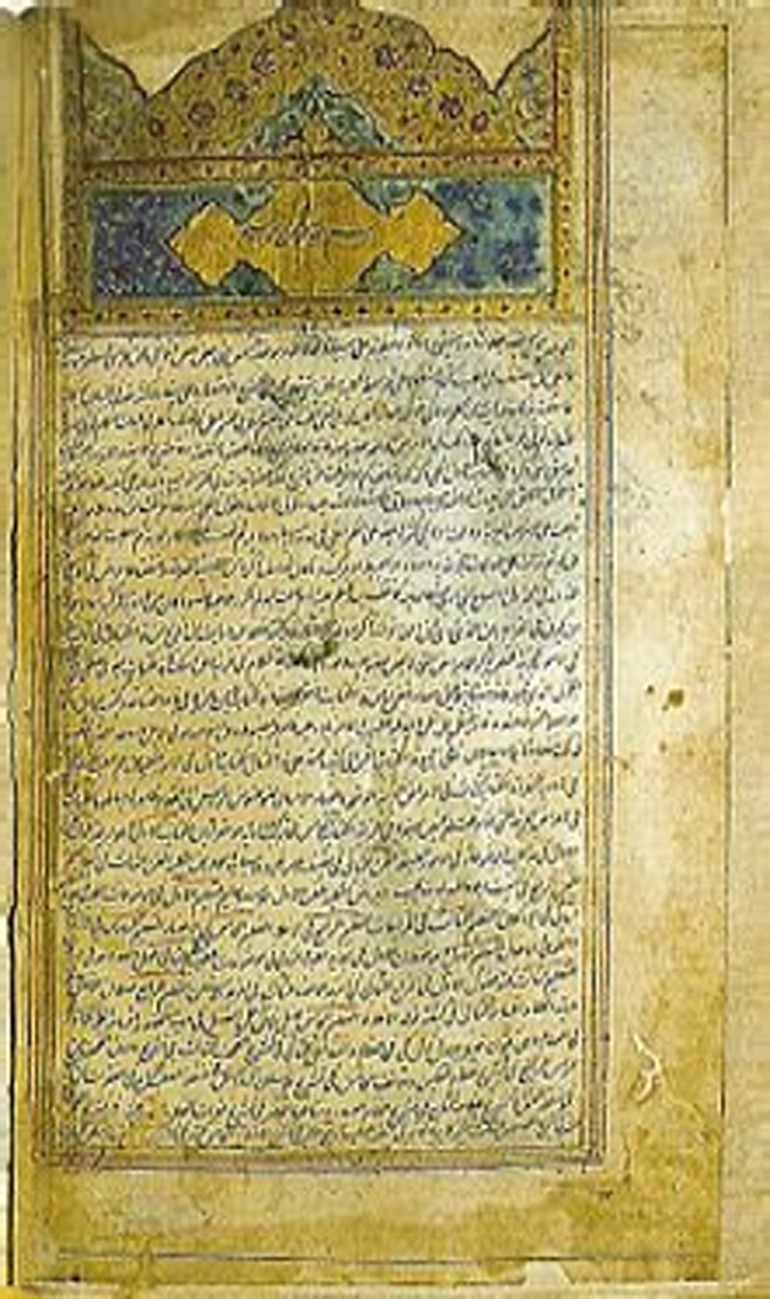
Avicenna's Canon of Medicine (ElKanon Fe ElTeb) was completed in 1025. The five volume book encompassed most of the medical knowledge of the time.
In the Commentary, Ibn Al-Nafis denied the presence of the inter-ventricular pores that allowed the passage of blood from the right to the left ventricle. He emphasized this point more than once in the script: “… but there is no passage between these two cavities [right and left ventricles]; for the substance of the heart is solid in this region and has neither a visible passage, as was thought by some persons, nor an invisible one which could have permitted the transmission of blood, as was alleged by Galen. The pores of the heart there are closed and its substance is thick.” and “There is no passage at all between these two ventricles; if there were the blood would penetrate to the place of the spirit [left ventricle] and spoil its substance. Anatomy refutes the contentions [of former authors]; on the contrary, the septum between the two ventricles is of thicker substance than other parts to prevent the passage of blood or spirits which might be harmful. Therefore the contention of some persons to say that this place is porous, is erroneous; it is based on the preconceived idea that the blood from the right ventricle had to pass through this porosity–and they are wrong.”
Ibn Al-nafis argued that since there was no communication between the right and left ventricles through the inter-ventricular septum, then the output of the right ventricle could only reach the left ventricle via the pulmonary circulation: “the blood after it has been refined in this cavity [right ventricle], must be transmitted to the left cavity where the [vital] spirit is generated.”. “For the penetration of the blood into the left ventricle is from the lung, after it has been heated within the right ventricle and risen from it, as we stated before.”
Moreover, in an inspired prediction to Malpighi's descriptions 400 years later on the pulmonary capillaries and alveoli, Ibn Al-Nafis stated that there must be small communications between the pulmonary artery and the pulmonary vein: “And for the same reason there exists perceptible passages (or pores, manafidh) between the two [blood vessels, namely pulmonary artery and pulmonary vein].”. Also, he wrote: “The lungs are composed of three parts, one of which is the bronchi, the second the branches of the arteria venosa and the third the branches of the vena arteriosa, all of them connected by loose porous flesh.”
Finally, Ibn Al-Nafis also described accurately the coronary circulation: “His (Avicenna's) statement that the blood that is in the right side is to nourish the heart is not true at all, for the nourishment to the heart is from the blood that goes through the vessels that permeate the body of the heart”. 15,16
Ibn Al-Nafis, the Man
The full name of Ibn Al-Nafis was Abu Al-Hassan Alaa Al-Deen Ali ibn Abi-Hazm al-Qarshi al-Dimashqi 17 . He was born in Qarsh, Syria, in 1213. Ibn Al-Nafis had his early medical education and practice in Damascus Medical College Hospital (Bimaristan Al-Noori) (Figure 14). Apart from medicine, he also learned jurisprudence, literature and theology. In 1236, moved to Cairo, Egypt where he initially worked at the Nur Al-Din Bimaristan. Subsequently he became chief of physicians at Bimaristan Al Mansouri. Other than his ground-breaking Commentary on Anatomy in Avicienna's Canon, Ibn Al-Nafis worked on his massive medical text book “El-Shamil” or the “The Comprehensive Book on the art of Medicine”. El-Shamil was an enormous body of work; some consider it one of the largest medical texts written by a single person, made of almost 300 books including most of medical sciences known at the time of Ibn Nafis. Unlike Avicenna's Canon and Rhazes' Comprehensive book of medicine, ElShamil was largely lost and only few scripts remain in the hands of historians today. Ibn Al-Nafis also wrote commentaries on Hippocrates, Avicenna, and Galen.
Figure 14.
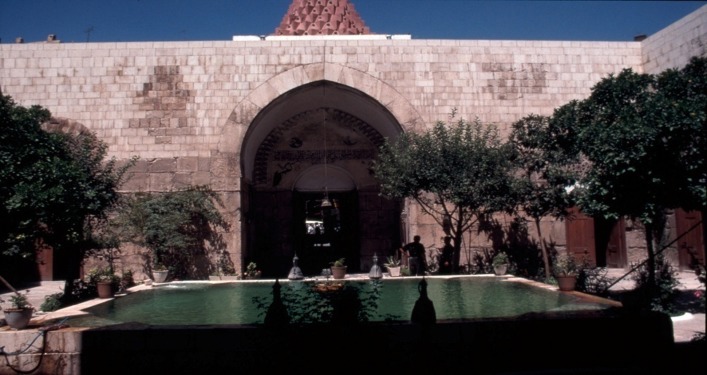
Nur al-Din Bimaristan is a large medieval bimaristan in Damascus, Syria. It is located in the al-Hariqa quarter in the old walled city, to the southwest of the Umayyad Mosque. It was built and named after the Zengid Sultan Nur al-Din in 1154. It was restored in 1975 and now houses the Museum of Medicine and Science in the Arab World.
Ibn Al-Nafis was not simply a physician but an exemplary polymath. Regarding philosophy and arts, Ibn Al-Nafis had works on the logic of Avicenna “The Signs” and “The Guidance”, and on Aristotle's Organon. Most importantly, Ibn Al-Nafis wrote “Theologus Autodidactus”, the first theological novel known in Arabic literature and an early example of science fiction and “coming-of-age” genres. In addition, Ibn Al-Nafis produced works on Arabic language “Road to Eloquence” and on Islamic studies “A short account on the methodology of Hadith”. Ibn Al-Nafis based his scientific approach on experimentation and direct observation. He was critical to past knowledge and challenged scientific dogmas. He also used the Aristotelian logic for scientific deduction. He wrote extensively on the importance of categorization and classification of sciences and diseases 17 .
The unresolved questions
A few intriguing questions remain: did Servetus and Realdo Colombo read about Ibn Al-Nafis' work on pulmonary circulation? Servetus was a revolutionist theologian and had explored many texts by Islamic philosophers like Averros. While researching the Arabic philosophy, did he come across Ibn Al-Nafis' commentary? Realdo Colombo was a Professor in the progressive University of Padua, which was under the influence of the Republic of Venice at his time. Venice was always the window of medieval Europe to the Orient. Moreover, many Venetians were passionate book and manuscript collectors. Did Colombo have access to Ibn Al-Nafis' work by then? Colombo and Servetus lived in the same time, and Padua was known to be the most autonomous scientific institute of that time. Did Servetus communicate with Colombo to share with him his findings, knowing that Padua may give him scientific refuge?
Conclusions
The cardiovascular anatomy and physiology remained elusive to the human knowledge for long years. Humanity took a long and winding road to comprehend the nature of blood circulation (Figure 15). All the aforementioned scientists were visionaries. Each persisted on searching for the Truth to the best of his capabilities. Each strived to pass on his scientific message to the future generations and Humanity after him.
“When hearing something unusual, do not preemptively reject it, for that would be folly. Indeed, unconventional things may be true, and familiar and praised things may prove to be lies. Truth is truth unto itself, not because many people say it is.” 17,18 (Figure 16)
Ibn Al-Nafis, “Commentary on Anatomy in Avicenna's Canon”
Figure 15.
The road to the discovery of circulation.
Figure 16.
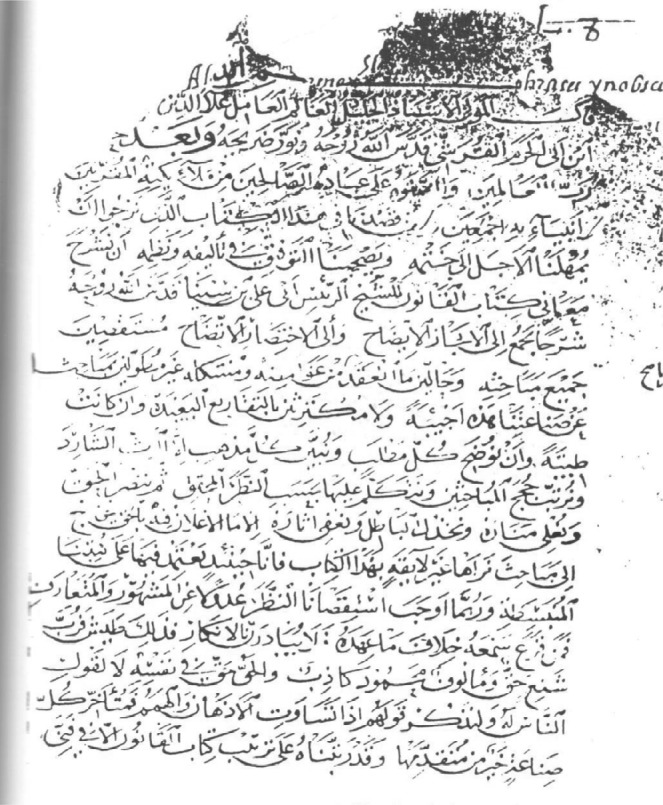
A photograph of the first page of the commentary on the Canon of Avicenna by Ibn Al-Nafis. Source: Zeidan Y. The rediscovery of Ibn Al-Nafis. 2008. ISBN: 9971442120.
References
- 1.Fishman AP. The pulmonary circulation. JAMA. 1978;239(13):1299–1301. [PubMed] [Google Scholar]
- 2.Willerson JT, Teaff R. Egyptian contributions to cardiovascular medicine. Tex Heart Inst J. 1996;23(3):191–200. [PMC free article] [PubMed] [Google Scholar]
- 3.Serageldin I. Ancient Alexandria and the dawn of medical science. Global Cardiology Science & Practice. 2013:47. doi: 10.5339/gcsp.2013.47. [DOI] [PMC free article] [PubMed] [Google Scholar]
- 4.Luce JV. Greek medicine from Asclepius to Hippocrates. Ir J Med Sci. 2001;(3):170,200–202. doi: 10.1007/BF03173893. [DOI] [PubMed] [Google Scholar]
- 5.Katz AM, Katz PB. Diseases of the heart in the works of Hippocrates. British Heart Journal. 1962;24(3):257–264. doi: 10.1136/hrt.24.3.257. [DOI] [PMC free article] [PubMed] [Google Scholar]
- 6.Aird WC. Discovery of the cardiovascular system: from Galen to William Harvey. Journal of Thrombosis and Haemostasis. 9(suppl. 1):118–129. doi: 10.1111/j.1538-7836.2011.04312.x. [DOI] [PubMed] [Google Scholar]
- 7.Stefanadis C, Karamanou M, Androutsos G. Michael Servetus (1511–1553) and the discovery of pulmonary circulation. Hellenic J Cardiol. 2009;50:373–378. [PubMed] [Google Scholar]
- 8.Zampieri F, Zanatta A, Elmaghawry M, Bonati MR, Thiene G. Origin and development of modern medicine at the university of Padua and the role of the “Serenissima” Republic of Venice. Global Cardiology Science and Practice. 2013:21. doi: 10.5339/gcsp.2013.21. [DOI] [PMC free article] [PubMed] [Google Scholar]
- 9.Vesalio A. De humani corporis fabrica libri septem. Basileae: per loannem Oporimum; 1543. [Google Scholar]
- 10.Colombo R. De re anatomica. Venetiis: ex typographia Nicolai Beuilacquae; 1559. [Google Scholar]
- 11.Fabrici D'Acquapendente G. De venarum ostiolis. Patavii: ex typographia Lauerntij Pasquati; 1603. [Google Scholar]
- 12.Harvey W. Exercitatio anatomica de motu cordis et sanguinis in anmalibus. Francofurti: Sumptibus Guilielemi Fizeri; 1628. [Google Scholar]
- 13.West JB. Marcello Malpighi and the discovery of the pulmonary capillaries and alveoli. Am J Physiol Lung Cell Mol Physiol. 2013;304:L383–L390. doi: 10.1152/ajplung.00016.2013. [DOI] [PubMed] [Google Scholar]
- 14.Haddad S, Khairallah A. A forgotten chapter in the history of circulation of the blood. Ann Surg. 1936 July;104(1):1–8. doi: 10.1097/00000658-193607000-00001. [DOI] [PMC free article] [PubMed] [Google Scholar]
- 15.Meyerhof M. Ibn An-Nafis (XIIIth Cent.) and his theory of the lesser circulation. Isis. 1935;23:100–120. [Google Scholar]
- 16.West JB. Ibn al-Nafis, the pulmonary circulation, and the Islamic Golden Age. J appl Physiol. 1880;105:1877–1880. doi: 10.1152/japplphysiol.91171.2008. [DOI] [PMC free article] [PubMed] [Google Scholar]
- 17.Zeidan Y. 2008. The rediscovery of Ibn Al-Nafis. ISBN: 9971442120. [Google Scholar]
- 18. http://www.serageldin.com/Files/Arabic_quotes.pdf. [Google Scholar]



